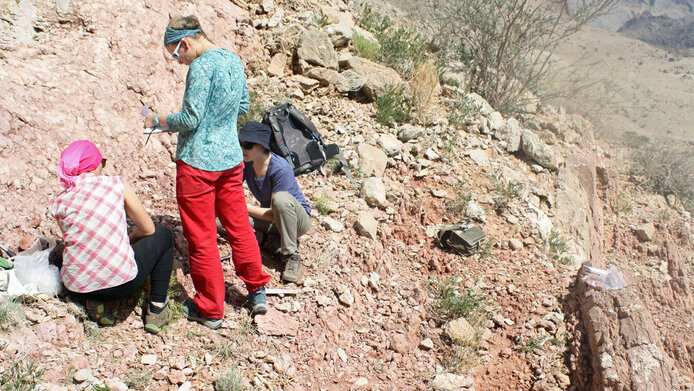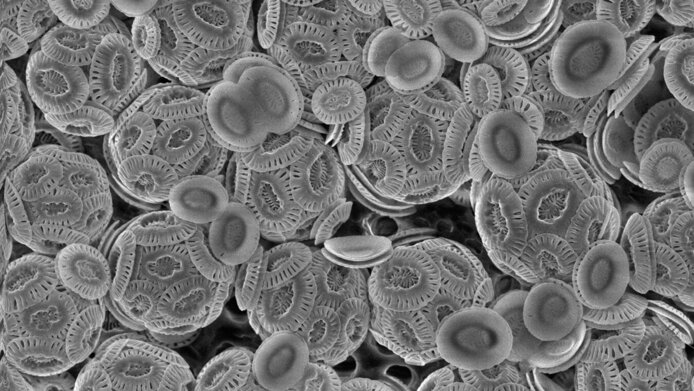Marine research in the Northern Calcareous Alps

For us, it is just a piece of rock, but it tells Sylvain Richoz a great deal more. The rock tells the geologist that it was there 200 million years ago, in a reef, with sponges, a few corals, a high degree of diversity and at constant salinity. “These rocks are like books, and we know how to read their pages,” enthuses Richoz. Apparently, the art of geology also requires a good imagination. For, while the scientist sees a lagoon, coastline and island in front of his mind’s eye, what he actually does is to climb around on the Nordkette, the Dachstein or the Tennengebirge. This is what the researchers explore in the field: how deep was the ocean at this point? Was it acidic? How high was the salinity? They are writing a fact sheet about a period that goes back 200 to 240 million years.
Sylvain Richoz is an expert on the Late Triassic, the third and final epoch of the Triassic Period in the geological time scale. One of the five major periods of mass extinction on Earth began at the end of this period. “I was impressed to see how evolution crashed and how life and species recovered again afterwards,” says the Swiss-born Richoz. He came to Austria as a postdoc and describes the country as a paradise for fans of this geological period, since the Northern Calcareous Alps or even a large part of the Vienna Woods were formed in the Triassic Period.
The Northern Calcareous Alps as a Great Barrier Reef
“The Northern Calcareous Alps were a kind of Great Barrier Reef of that period,” Richoz notes with enthusiasm. “The Gosaukamm and the Tennengebirge were huge reefs in the ocean and that's why Austria is the best place for ocean research!” He is particularly interested in how the chemical composition of the ocean affects life, and how life in turn affects the chemistry of the ocean. Why do we want to know this in 2021? – Well, the ocean absorbs a third of human CO2 emissions and, as Richoz explains, there are physical and biological reasons for this. Microorganisms in the ocean act like a kind of biological pump which transfers a large part of the absorbed carbon dioxide into the ocean’s depths as organic carbon compounds. “Single-cell algae, called phytoplankton, are particularly important. They absorb CO2 from the atmosphere and convert it through photosynthesis,” says Richoz.
Climate change and its consequences for calcareous algae
Richoz tells us about the many species and genera of phytoplankton, the ones of special interest being the almost unpronounceable coccolithophores. They have a calcareous shell, which makes them heavier, and so they sink faster to the bottom of the sea. According to Richoz, this has an enormous influence on the climate and on seawater chemistry. With his team, he is therefore investigating the following questions: What influence did the development of calcareous nannoplankton have already at an early stage of its evolution? Is there a risk of the ocean turning acidic? How does CO2 affect this type of calcareous algae? Initial results show that they suffer greatly from the rise in this greenhouse gas. However, it is not known how they will react in the long term.

“Like everyone else, I am, of course, concerned about climate change. The earth has already gone through crises and recovered. I'm sure the planet won't die. It has been through worse, but we will suffer. The change will put a strain on our society,” Richoz notes with conviction. Then he takes another look back to the time before the coccolithophores: “Before that, there wasn't a single organism that could build a shell in the open ocean; they all existed merely along oceanic coasts. But then, suddenly, one organism was different. That was important for the ocean’s chemistry and its pH value,” is how Richoz explains the ability of the armoured algae to take carbon dioxide into the depths and stabilize the pH value.
“We know they weren't there 240 million years ago, but there they were 220 million years ago,” says Richoz. That is the age of the rocks the research team is looking for around Hallstatt above the salt mine. The five-micrometre remains are magnified 2,000 times under the special microscope or even 8,000 times under the electronic microscope. “What we see then is quite beautiful: a small shell with fine detail, a very tiny complicated structure.”
Salzkammergut, Oman and Turkey
In addition to the field research in the Salzkammergut, they also searched in Oman, the Emirates and Turkey. “We need to know if the phenomenon is regional or global. We need marine rocks of this age and we need to be sure that they have not been altered too much in the mountain-building process,” adds Richoz. A great deal of research is being done on phytoplankton, but most of it focuses on shorter time periods. How do researchers actually know if the rock is 200 or 250 million years old? “We are helped by our knowledge of fossil evolution. There are some that change rapidly and you can use them as time markers,” Richoz explains and shows us a picture of a spiral-shaped ammonite, the cephalopod with the shell, and says, “The structure of these animals changes quite rapidly and we know that they belong to a certain time period.” The researchers need to spend a lot of time in the field to find them, but at least they are assisted by 100 years of paleontological knowledge. The first publication describing ammonites discovered in Hallstatt dates back to 1896.
Up to now no effect on ocean chemistry has been detected. “We have a better understanding now, but our assumption that the evolution of coccolithophores would have a more rapid impact on the chemical stability of the ocean turned out to be wrong.” It was rather the other way around, Richoz notes: massive weathering of the mountains rapidly changed the chemistry of the ocean and gave a boost to the evolution of phytoplankton. Apart from that, the observations point to a rather slow evolution: “We were surprised by the fact that the coccolithophores evolve so slowly. And there was another surprise: we found traces of the oldest coccoliths, these tiny disc-shaped platelets of calcium carbonate that form the shell of calcareous algae of the order coccolithophores.
Mountains have stories to tell
Sylvain Richoz has always been fascinated by mountains. Before graduating from school, he was looking for a subject related to mountains and found geology. “The world of mountains is fascinating. It has such a lot of history to tell.” One of the leading experts on the Northern Calcareous Alps, Richoz meanwhile lives a thousand kilometres to the north in Sweden. “My new projects in Lund continue to deal with the geology of Austria, but from a distance,” explains Richoz, who regularly brings students to Austria “so that they can see real mountains.”
Personal details
Sylvain Richoz is a native of Lausanne, where he received his PhD in geology and geochemistry in 2005. After various research stays in Vienna, Frankfurt and Graz, he has been teaching and researching at the Department of Geology at Lund University in southern Sweden since 2017. His research moves between palaeontology and geochemistry, with a focus on the early Mesozoic, and, geographically speaking, extends from the Alps to the Himalayas. The project “The origin of pelagic calcification and its influence on seawater chemistry” (2016-2020) was funded by the Austrian Science Fund FWF with 349,000 euros.
Publications
Demangel I., Howe R., Gardin S., Richoz, S.: Eoconusphaera hallstattensis, new species, and review of the Rhaetian genus Eoconusphaera, in: Journal of Nannoplankton Research 39-1, 2021
Kovács Z., Demangel I., Richoz S., Hippler D., Baldermann A., Krystyn L.: New constraints on the evolution of 87Sr/86Sr of seawater during the Upper Triassic, in: Global and Planetary Change, 192, 2020
Demangel I., Kovács Z., Richoz S., Gardin, S., Krystyn, L., Baldermann, A and Piller, W.E.: Development of early calcareous nannoplankton in the Late Triassic (Northern Calcareous Alps, Austria), in: Global and Planetary Change, 193, 2020





